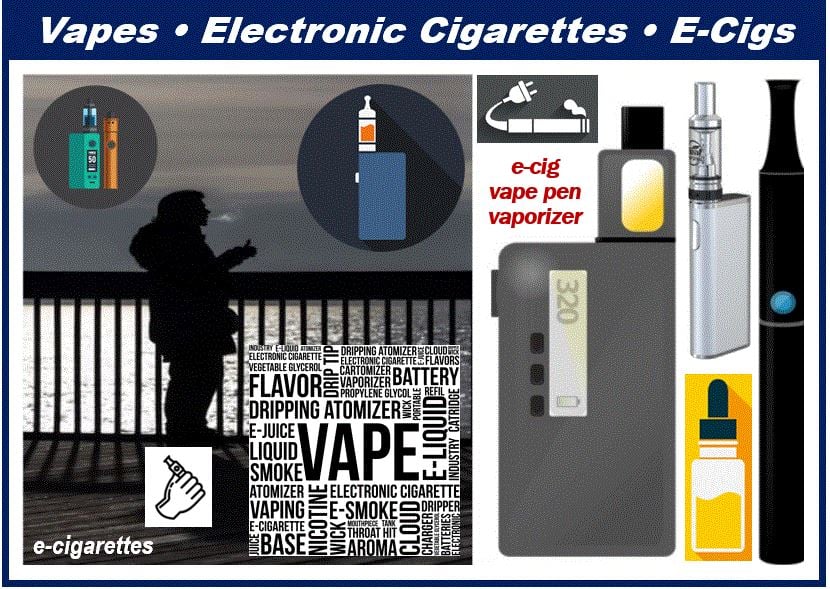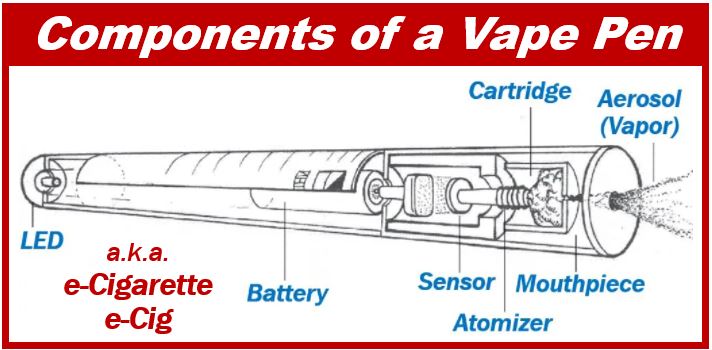Vaping involves inhaling and exhaling vapor, i.e., an aerosol solution, which contains flavoring. In many cases, the vapor also contains nicotine. For some people, vaping, i.e., using a battery-operated e-cigarette, is an alternative to smoking tobacco products. Others, on the other hand, vape because they like the flavors. Unfortunately, among teenagers, it is commonly viewed as a desirable status symbol.
While vaping is often marketed as a lifestyle choice, public health campaigns are increasingly highlighting the importance of understanding the potential risks and benefits associated with e-cigarette use.

Many people who used to smoke tobacco products switched to vaping because it is less damaging for the health. Vaping simulates the experience smokers used to have with a traditional cigarette, but without all the smoke, tar, and thousands of toxic chemicals.
Vapers use a solution which we call e-liquid or e-juice. Below is a list of alternative names for vaping devices:
- Vaporizers
- Vapes
- Vape Pens
- ENDS (Electronic Nicotine Delivery Systems)
- Mods
- e-Pipes
- e-Cigs
- e-Cigarettes
- e-Hookahs
Vaping helps people quit smoking
According to the National Health Service (NHS), thousands of people across the United Kingdom have managed to stop smoking successfully and permanently thanks to vaping. There is clear evidence today that it is effective. The National Health Service (NHS) is the publicly funded healthcare system of the United Kingdom. It provides free universal healthcare.
People who are addicted to nicotine report that using e-cigarettes satisfies that craving in the same way traditional tobacco products do.
According to the NHS:
“A major UK clinical trial published in 2019 found that, when combined with expert face-to-face support, people who used e-cigarettes to quit smoking were twice as likely to succeed as people who used other nicotine replacement products, such as patches or gum.”
How safe or harmful is vaping?
Vaping is not completely risk free. You are better off not smoking or vaping at all. However, e-cigarettes carry a tiny fraction of the health risks of tobacco cigarettes.
The vaper does not inhale carbon monoxide or tar, two very harmful elements that are present in tobacco smoke.
If you are a lifetime non-smoker, beware of inhaling nicotine from e-cigs. Nicotine is a highly addictive substance. Remember that if you are a regular smoker vaping is a healthier alternative, but if you are a lifetime nonsmoker, vaping is definitely an unhealthy choice!
How does a vape pen or e-cig work?

Electronic nicotine delivery systems, i.e., e-cigs or vape pens, have the following components:
- A cartridge which holds the e-liquid. There are literally hundreds of different flavors today. Most e-liquids contain nicotine.
- There is a heating element, which we call an atomizer. The atomizer turns the liquid into an aerosol (mist) that the vaper inhales.
- A mouthpiece that you suck as you would the filter tip or end of a traditional cigarette.
- A battery.
The global e-Cig market
Since the beginning of this century, the number of electronic cigarettes sold has increased significantly. This rapid growth slowed down slightly in 2015. There are today at least 500 different e-cig brands globally.
From 2014 to 2019, global sales increased from $7 billion to $19.3 billion. Experts believes that e-cigarette sales will be greater than those of tobacco cigarettes by 2023. Online purchases represented between 30% and 50% of all e-cig sales. Most established tobacco businesses have invested in the e-cig market.
Environmental concerns also arise with vaping, as disposable e-cigarettes and used cartridges contribute to electronic waste, which presents a challenge for waste management and recycling efforts.
According to a study published by Grand View Research:
“The global e-cigarette and vape market size was valued at USD 15.04 billion in 2020 and is expected to expand at a compound annual growth rate (CAGR) of 28.1% from 2021 to 2028.”
“The growing emphasis on adopting safer alternatives to smoking is anticipated to drive the adoption of e-cigarettes and vape devices over the forecast period.”
A relatively new term
The term “vaping,” related to electronic cigarettes, emerged around the beginning of this century, following the invention of the modern e-cigarette.
As e-cigarettes became more widely used and commercially available, so did the noun “vaping” and verb “to vape.”
Both terms were added to major dictionaries. In 2014, the Oxford Dictionary chose “vape” as the Word of the Year.
Video – What is Vaping?
This video, from our sister channel on YouTube – Marketing Business Network, explains what ‘Vaping’ is using simple and easy-to-understand language and examples.
